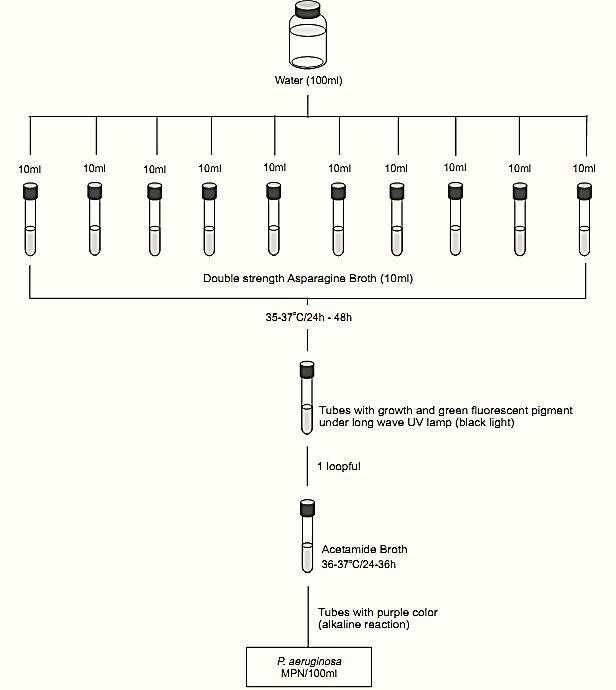


 النبات
النبات
 الحيوان
الحيوان
 الأحياء المجهرية
الأحياء المجهرية
 علم الأمراض
علم الأمراض
 التقانة الإحيائية
التقانة الإحيائية
 التقنية الحيوية المكروبية
التقنية الحيوية المكروبية
 التقنية الحياتية النانوية
التقنية الحياتية النانوية
 علم الأجنة
علم الأجنة
 الأحياء الجزيئي
الأحياء الجزيئي
 علم وظائف الأعضاء
علم وظائف الأعضاء
 الغدد
الغدد
 المضادات الحيوية
المضادات الحيوية| Most probable number (MPN) method APHA/AWWA/WEF 2005 for Pseudomonas aeruginosa in water |
|
|
|
Read More
Date: 9-3-2016
Date: 2025-02-06
Date: 18-3-2016
|
Most probable number (MPN) method APHA/AWWA/WEF 2005 for Pseudomonas aeruginosa in water
Method of the American Public Health Association (APHA), American Water Works Association (AWWA) & Water Environment Federation (WEF), as described in the Standard Methods for the Examination of Water and Wastewater (Hunt & Rice, 2005).
1. Material required for analysis
Preparation of the sample and serial dilutions
• Magnesium Chloride Phosphate Buffer (Dilution Water)
• Dilution tubes containing 9 ml Magnesium Chloride Phosphate Buffer (Dilution Water)
• Asparagine Broth double strength (10 ml tubes)
• Asparagine Broth single strength (10 ml tubes)
• Acetamide Agar or Acetamide Broth
• Laboratory incubator set to 35–37°C
2. Procedure
A general flowchart for the enumeration of Pseudomonas aeruginosa in water using the Most Probable Number (MPN) method APHA/AWWA/WEF 2005 is shown in Figure 1.
a) Presumptive test: Homogenize the sample by shaking vigorously about 25 times. For potable water apply a MPN single dilution test, inoculating 10 × 10 ml aliquots of the sample onto 10 × 10 ml of double strength Asparagine Broth (it is also possible to inoculate 5 × 20 ml aliquots of the sample onto 5 × 20 ml of double strength Asparagine Broth or 5 × 10 ml of triple strength Asparagine Broth).

Figure.1 Scheme of analysis for the enumeration of Pseudomonas aeruginosa in water using the Most Probable Number (MPN) method APHA/AWWA/WEF 2005 (Hunt & Rice, 2005).
For non-potable water select three appropriate dilutions and apply a MPN multiple dilution test, inoculating three tubes of Asparagine Broth per dilution. Incubate the samples at 35–37°C/24–48. After 24 h examine the tubes under long-wave ultra-violet light (black light) in a darkened box or room. The production of a green fluorescent pigment constitutes a positive presumptive test. Re-incubate the negative tubes for an additional 24 h and examine and record reactions again at 48 h.
b) Confirmed test: From each presumptive tube inoculate 0.1 ml of culture into Acetamide Broth or onto Acetamide Agar slants. Incubate the tubes at 35–37°C/24–36 h. Development of purple color (alkaline reaction) within 24 to 36 h of incubation is a positive confirmed test for P. aeruginosa.
c) Calculation of results: Make a note of the number of positive tubes and determine the most probable number (MPN)/ml .
References
Silva, N.D .; Taniwaki, M.H. ; Junqueira, V.C.A.; Silveira, N.F.A. , Nasdcimento , M.D.D. and Gomes ,R.A.R .(2013) . Microbiological examination methods of food and water a laboratory Manual. Institute of Food Technology – ITAL, Campinas, SP, Brazil .
Hunt, M.E. & Rice, E.W. (2005) Microbiological examination. In: Eaton, A.D., Clesceri, L.S., Rice, E.W. & Greenberg, A.E. (eds). Standard Methods for the Examination of Water & Wastewater. 21st edition. Washington, American Public Health Association (APHA), American Water Works Association (AWWA) & Water Environment Federation (WEF). Part 9213, pp. 9.33–9.34.



|
|
|
|
لشعر لامع وكثيف وصحي.. وصفة تكشف "سرا آسيويا" قديما
|
|
|
|
|
|
|
كيفية الحفاظ على فرامل السيارة لضمان الأمان المثالي
|
|
|
|
|
|
|
قسم التربية والتعليم يطلق الامتحانات النهائية لمتعلِّمات مجموعة العميد التربوية للبنات
|
|
|